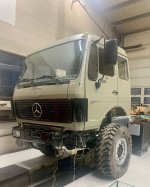bomonster
New member
My wife and I have been dreaming of a full-time overlanding life for a long time. After years of planning and saving, this is the year we're finally making it a reality.
We're not strangers to adventure travel. We've tackled overland traverses across Alaska, Patagonia, Bolivia, Newfoundland, Iceland, and the USA. But these were always short trips – 2-3 weeks of rushing through incredible landscapes. We craved more – the freedom and flexibility of full-time exploration.
Over the past decade, we've learned a lot about what we want in an overlanding vehicle. We've graduated from camping in sedans to a 100 Series Land Cruiser and now to our current setup with an off-road trailer. We've realized that there's no perfect time to embark on this journey. The best time is now, while we're healthy and can enjoy it to the fullest.
Our Goal: To travel full-time for the next 15-17 years in a comfortable and capable vehicle. We don't need a palace on wheels, but we want something that will age gracefully with us.
Our Strategy: We're taking a unique approach to our build. We plan to source a former fire engine in Germany – a 1990 Mercedes-Benz 1225 AF with a powerful 14.6-liter V8. We'll have the structural work, including a "Short Doka" conversion, completed in Germany before shipping a weather-resistant shell to the US. We'll then handle the interior build ourselves.
The Fire Engine Spec:
And last but not the least sharing our dilemmas and learning from folks who have done it.
We're not strangers to adventure travel. We've tackled overland traverses across Alaska, Patagonia, Bolivia, Newfoundland, Iceland, and the USA. But these were always short trips – 2-3 weeks of rushing through incredible landscapes. We craved more – the freedom and flexibility of full-time exploration.
Over the past decade, we've learned a lot about what we want in an overlanding vehicle. We've graduated from camping in sedans to a 100 Series Land Cruiser and now to our current setup with an off-road trailer. We've realized that there's no perfect time to embark on this journey. The best time is now, while we're healthy and can enjoy it to the fullest.
Our Goal: To travel full-time for the next 15-17 years in a comfortable and capable vehicle. We don't need a palace on wheels, but we want something that will age gracefully with us.
Our Strategy: We're taking a unique approach to our build. We plan to source a former fire engine in Germany – a 1990 Mercedes-Benz 1225 AF with a powerful 14.6-liter V8. We'll have the structural work, including a "Short Doka" conversion, completed in Germany before shipping a weather-resistant shell to the US. We'll then handle the interior build ourselves.
The Fire Engine Spec:
- Base Truck: 1990 Mercedes-Benz 1225 AF
- Engine: OM 422 V8, 14.6 liters
- Mileage: Incredibly low at approximately 16,000 miles
- Wheelbase: 365 cm
- Upgrades in progress:
- The Truck will be known as "Gimli II" henceforth
- New rear brakes/Front ones are great
- Air tanks inside the frame
- Additional air tank for auxiliary systems
- New batteries
- Heated fuel filters (SEPA SWK-2000/5-50)
- Faster axle gear ratio (43:10)
- Upgraded 110A alternator
- New, synchronized injectors for improved performance (300hp)
- Short DOKA and Complete cabin strip-down and repaint
- 46-inch Super Single tires (385/85/R20) with two spares
- Underbody protection with 80mm alubutyle
- LED Lights
- Marquart Shocks
- Parabolic spring upgrade
- 90 cm x 60 cm pass-through
And last but not the least sharing our dilemmas and learning from folks who have done it.

